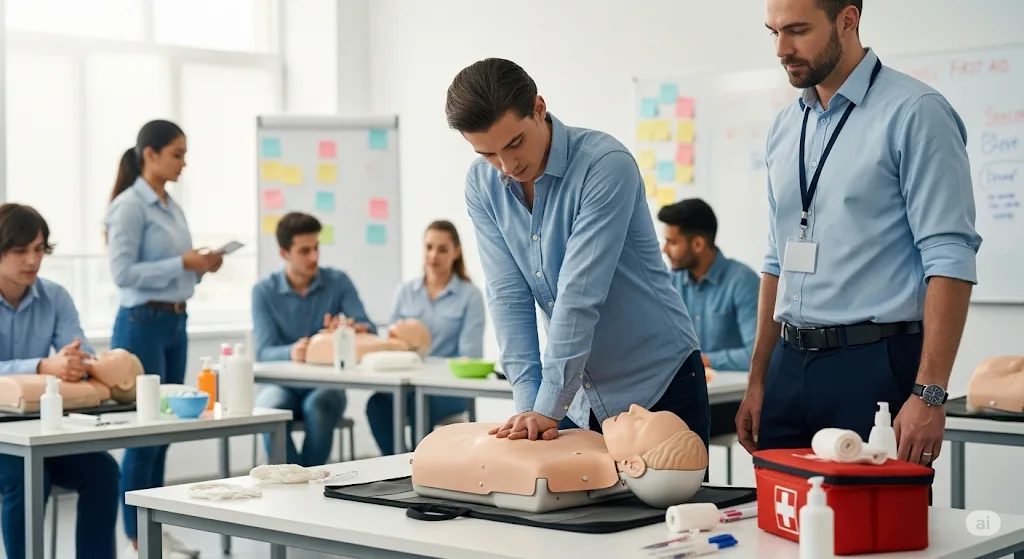
Emergencies can happen anywhere — at home, at work, or in public spaces — and knowing how to respond can make the difference between life and death. In the UK, first aid training has become increasingly important, not only for healthcare professionals but also for teachers, parents, employees, and ordinary citizens. By enrolling in a first aid course, you gain the knowledge and confidence to act quickly in emergencies, provide essential care until professional help arrives, and potentially save lives. This article explores the structure, benefits, and opportunities of first aid courses in the UK, highlighting why they are vital skills for everyone.
Why First Aid Training Matters
The Reality of Medical Emergencies
Medical emergencies don’t announce themselves conveniently. They occur in homes, workplaces, public spaces, and during leisure activities—often when professional help is minutes away. The average ambulance response time in England for Category 2 emergencies (including strokes and heart attacks) currently stands at approximately 30 minutes, according to NHS England statistics.
During these critical minutes, appropriate first aid intervention can:
Preserve Life: CPR administered within the first 3-5 minutes of cardiac arrest increases survival chances by 50-70%. Every minute of delay reduces survival probability by approximately 10%.
Prevent Deterioration: Proper wound management prevents excessive blood loss. Correct positioning helps maintain airways. Appropriate responses to allergic reactions slow symptom progression until advanced care arrives.
Promote Recovery: Early intervention often reduces injury severity and long-term complications. Burns treated promptly within the first few minutes experience less tissue damage. Fractures properly immobilised cause less secondary injury.
Provide Reassurance: Casualties experiencing trauma often feel intense fear and panic. A calm, knowledgeable responder provides psychological comfort alongside physical care, which itself contributes to better outcomes.
Legal and Workplace Requirements
While the UK doesn’t legally require most citizens to hold first aid qualifications, specific circumstances create obligations:
Workplace Requirements: The Health and Safety (First Aid) Regulations 1981 require employers to provide adequate first aid equipment, facilities, and trained personnel. The number of required first aiders depends on workplace size, nature of work, and assessed risks.
Childcare Settings: Ofsted regulations mandate that childcare providers must have at least one person with paediatric first aid certification present at all times when children are present.
Sports Coaching: Many sports governing bodies require coaches to hold current first aid qualifications appropriate to their sport, particularly when working with children or in environments with higher injury risks.
Driving Instructors: While not legally mandatory for car instructors, first aid training is increasingly expected. HGV and professional driving roles often require certification.
Volunteering Roles: Many volunteer positions—from Scout leaders to community event organisers—require or strongly prefer first aid qualified individuals.
Beyond formal requirements, first aid skills provide competitive advantage in employment markets. Many employers view certification positively, demonstrating responsibility, practical capability, and commitment to workplace safety.
Personal and Family Protection
Professional applications aside, first aid knowledge offers profound personal value. Parents of young children face daily risks—choking, burns, falls, fevers, and allergic reactions represent common childhood emergencies. Elderly family members may experience falls, heart issues, or strokes where immediate response critically affects outcomes.
Consider that most accidents occur in homes. Kitchen injuries, bathroom slips, garden mishaps, and DIY accidents happen regularly. Having confident, trained individuals in households significantly improves emergency response capabilities.
Understanding First Aid Qualification Levels
Emergency First Aid at Work (EFAW)
Duration: 1 day (6 hours contact time)
Certification Validity: 3 years
Who It’s For: Low-risk workplaces, small businesses, individuals seeking basic workplace compliance
Content Covered:
- Understanding roles and responsibilities of first aiders
- Assessing incidents and prioritising casualties
- Managing unconscious casualties
- CPR and use of automated external defibrillators (AEDs)
- Choking management in adults
- Control of bleeding and shock management
- Minor injuries (small cuts, grazes, minor burns)
Limitations: Doesn’t cover paediatric emergencies, fractures, or many specific injury types. Suitable only for workplaces where serious injuries are unlikely.
Cost: £60-£120 per person
Best For: Office environments, retail settings, administrative roles, or individuals wanting basic emergency knowledge without comprehensive detail.
First Aid at Work (FAW)
Duration: 3 days (18 hours contact time)
Certification Validity: 3 years
Who It’s For: Higher-risk workplaces, designated workplace first aiders, those requiring comprehensive qualification
Content Covered:
- All EFAW content plus:
- Managing casualties with chest injuries, spinal injuries, and head injuries
- Fractures and dislocations
- Eye injuries
- Poisoning and anaphylaxis
- Burns and scalds (all severities)
- Asthma attacks
- Diabetes emergencies
- Seizures
- Heart attacks and strokes
- Secondary survey and ongoing casualty care
Legal Status: Meets Health and Safety Executive (HSE) requirements for workplace first aiders in all environments
Cost: £180-£350 per person
Best For: Manufacturing, construction, hospitality, healthcare support roles, or anyone wanting thorough, workplace-compliant qualification.
Paediatric First Aid
Duration: 2 days (12 hours contact time)
Certification Validity: 3 years
Who It’s For: Parents, childcare workers, teachers, sports coaches working with children
Content Covered:
- Infant and child CPR (different techniques than adult)
- Managing unconscious infants and children
- Choking in babies and children
- Anaphylaxis and severe allergic reactions
- Meningitis recognition
- Febrile seizures
- Asthma in children
- Childhood injuries (falls, burns, head injuries)
- Sudden infant death syndrome awareness
Regulatory Compliance: Meets Ofsted and Early Years Foundation Stage requirements
Cost: £120-£250 per person
Best For: Anyone regularly responsible for children, particularly in professional childcare capacity. Essential for nursery staff, childminders, and teaching assistants.
Specialist First Aid Courses
Mental Health First Aid (2 days)
Focuses on recognising mental health crises, providing initial support, and guiding people toward appropriate professional help. Increasingly important given mental health challenges affecting one in four UK adults annually.
Cost: £200-£350
Outdoor First Aid (2-3 days)
Designed for remote environments where professional help may be hours away. Covers extended casualty care, improvised equipment, environmental injuries (hypothermia, heat exhaustion), and evacuation decisions.
Cost: £200-£400
Sports First Aid (1-2 days)
Addresses sport-specific injuries—sprains, dislocations, concussion, overexertion complications. Tailored for coaches, personal trainers, and sports event organisers.
Cost: £100-£200
Marine/Offshore First Aid
Specialist qualification for maritime environments, covering unique challenges of providing care at sea, including extended periods before evacuation.
Cost: £300-£500
Annual Refresher Training
First aid skills deteriorate without practice. Most certifications require renewal every three years through full requalification courses. However, annual refresher training (typically 3-4 hours) helps maintain competency and confidence between full certifications.
Cost: £40-£80 annually
Benefits: Reinforces critical skills, updates knowledge with current guidelines, maintains muscle memory for emergency procedures, and demonstrates ongoing commitment to capability.
Leading First Aid Training Providers in the UK
1. St John Ambulance
Reputation: UK’s leading first aid charity with over 140 years’ experience. Most recognised provider with nationwide coverage.
Courses Offered: Complete range from basic awareness to advanced qualifications, including EFAW, FAW, paediatric, and specialist courses
Cost: £65-£350 depending on course level
Highlights:
- Charitable organisation reinvesting profits into community services
- Over 500 training venues across UK
- Highly experienced instructors, many with emergency services backgrounds
- Strong focus on practical, scenario-based learning
- Equipment loans for community groups
Delivery Options: Classroom, workplace in-house training, and blended learning with online theory
Best For: Those seeking established reputation, widespread availability, and supporting charitable mission.
2. British Red Cross
Reputation: International humanitarian organisation with extensive emergency response and training expertise.
Courses Offered: EFAW, FAW, paediatric, AED training, mental health first aid
Cost: £70-£340 depending on course
Highlights:
- Focus on building resilient communities
- Culturally sensitive training approaches
- Free or subsidised courses for vulnerable groups and charities
- International recognition valuable for overseas work
- Emphasis on psychological aspects of emergency response
Delivery Options: Public courses, workplace training, tailored programmes for specific sectors
Best For: Those valuing international perspective, community focus, and humanitarian ethos.
3. ProTrainings
Reputation: Leading provider of regulated and nationally recognised qualifications, including significant online provision.
Courses Offered: EFAW, FAW, paediatric, AED, anaphylaxis awareness, plus extensive specialist options
Cost: £50-£300 for blended/classroom courses; £20-£50 for online-only awareness courses
Highlights:
- Extensive blended learning options (online theory, in-person practical assessment)
- Highly flexible for busy professionals
- Very competitive pricing
- Courses accredited by multiple awarding bodies
- Regular offers and multi-person discounts
Delivery Options: Fully online awareness courses, blended learning, traditional classroom
Best For: Budget-conscious learners, those requiring maximum flexibility, or groups seeking cost-effective training.
4. Qualsafe Awards
Reputation: Ofqual-regulated awarding organisation providing qualifications through approved training centres nationwide.
Courses Offered: Complete range of regulated first aid, health and safety, and compliance qualifications
Cost: Varies by training centre (typically £60-£320)
Highlights:
- Regulated qualifications ensuring consistent quality standards
- Network of approved centres across UK
- Strong workplace focus with HSE-compliant courses
- Integration with other health and safety training
- Recognised by insurance providers and regulatory bodies
Delivery Options: Through approved centres offering classroom and workplace training
Best For: Those seeking regulatory-backed qualifications, workplace compliance requirements, or integrated health and safety training.
5. First Aid Training Cooperative (FATCO)
Reputation: Nationwide network of independent trainers providing flexible, community-focused training.
Courses Offered: EFAW, FAW, paediatric, plus tailored courses for specific groups
Cost: £55-£280 depending on location and course
Highlights:
- Local trainers embedded in communities
- Highly personalised service
- Often more flexible with scheduling and location
- Competitive pricing
- Strong customer service focus
Delivery Options: Public courses, workplace training, home visits for small groups
Best For: Those preferring local, personalised service or requiring flexible arrangements.
6. RLSS UK (Royal Life Saving Society)
Reputation: Specialist provider focusing on aquatic and water safety first aid.
Courses Offered: Standard first aid qualifications plus water-specific emergency response
Cost: £80-£300
Highlights:
- Specialist expertise in drowning response and water rescue
- Essential for swimming instructors, lifeguards, water sports instructors
- Pool-based practical components where relevant
- Nationally recognised qualifications
Best For: Anyone working in aquatic environments or responsible for water-based activities.
Course Content: What You’ll Actually Learn
Practical Skills Development
First aid courses emphasise hands-on practice over theoretical knowledge. Expect significant time practising on training manikins, applying bandages to classmates, and working through realistic emergency scenarios.
Cardiopulmonary Resuscitation (CPR)
You’ll practice chest compressions on adult, child, and infant manikins (depending on course level), learning correct hand position, compression depth (5-6cm for adults), compression rate (100-120 per minute), and ratio of compressions to rescue breaths (30:2). Modern training includes AED familiarisation—automated devices now found in many public spaces that significantly improve cardiac arrest survival rates.
Airway Management
Learn to assess and maintain airways in unconscious casualties, including recovery position techniques that prevent airway obstruction whilst protecting spinal integrity. Practice recognising breathing patterns indicating problems and responding appropriately.
Bleeding Control
Develop confidence applying direct pressure to wounds, using elevation where appropriate, and applying appropriate dressings and bandages. Learn to recognise and respond to severe bleeding requiring immediate intervention versus minor wounds needing basic care.
Choking Response
Practice back blows and abdominal thrusts (Heimlich manoeuvre) on training aids. Learn to distinguish mild versus severe choking and appropriate responses for conscious versus unconscious casualties. Paediatric courses cover modified techniques for infants.
Fracture and Sprain Management
Understand principles of immobilisation, practice applying slings and improvised splints, and learn to distinguish fractures from sprains. Emphasis on preventing movement that could worsen injuries whilst awaiting professional care.
Burns and Scalds
Learn the “cool, cover, comfort” approach—cooling burns immediately with water (not ice), covering with appropriate materials, and providing reassurance. Understand when burns require emergency medical attention versus basic first aid.
Scenario-Based Learning
Quality courses incorporate realistic scenarios where you assess situations, prioritise multiple casualties, communicate with emergency services, and provide appropriate care whilst managing stress and time pressure.
Example scenarios include:
- Workplace accidents with unconscious casualties
- Road traffic incidents with multiple injuries
- Anaphylaxis requiring EpiPen administration
- Child experiencing seizures
- Elderly person with stroke symptoms
These scenarios build confidence for real emergencies by simulating decision-making under pressure, managing emotional responses, and applying learned skills in context.
Assessment and Certification
Continuous Assessment: Instructors observe your practical technique throughout courses, providing feedback and guidance to ensure competency.
Practical Examinations: Most courses include formal practical assessments where you demonstrate key skills—typically CPR, recovery position, bleeding control, and scenario management.
Theory Assessment: Some qualifications include multiple-choice exams or verbal questioning testing knowledge of emergency response principles, anatomy basics, and appropriate actions for various conditions.
Certification Requirements: You must demonstrate competency in all assessed areas to receive certification. Failed assessments typically allow retest opportunities.
Successful completion results in certification valid for three years, including wallet cards proving qualification for workplace or regulatory purposes.
Career Applications and Professional Benefits
Employment Advantages
First aid certification enhances employability across sectors:
Mandatory Requirements: Certain roles legally require first aid qualifications—childcare workers, care home staff, outdoor education instructors, and designated workplace first aiders. Without certification, you’re ineligible for these positions.
Competitive Edge: When employers choose between similarly qualified candidates, first aid certification often tips decisions. It demonstrates responsibility, practical skills, and workplace safety awareness.
Leadership Opportunities: First aid qualified employees often receive additional responsibilities, team leadership roles, or health and safety committee positions—all contributing to career progression.
International Work: Many countries recognise UK first aid qualifications, particularly from established providers like St John Ambulance or British Red Cross. This proves valuable for international employment or travel work.
Salary Implications
While first aid certification alone rarely justifies salary increases, it contributes to overall professional value:
Combined Qualifications: First aid alongside other health and safety certifications (fire safety, risk assessment, manual handling) creates comprehensive safety competency valuable in supervisory and management roles.
Designated First Aider Allowances: Some organisations pay small allowances (£500-£1,500 annually) to designated workplace first aiders recognising additional responsibility.
Career Progression: First aid qualification often features in progression to supervisory roles where broader responsibility includes workplace safety—these roles typically carry 10-20% salary increases.
Voluntary and Community Impact
Beyond employment, first aid skills enable meaningful community contribution:
Volunteer First Aiding: St John Ambulance and British Red Cross offer opportunities to volunteer at public events—festivals, sports matches, community gatherings—providing medical cover whilst maintaining skills.
Community Training: Experienced first aiders often become trainers themselves, teaching others whilst earning additional income (£150-£400 per training day).
Youth Organisations: Scout groups, cadet forces, and youth clubs actively seek first aid qualified volunteers to lead activities safely.
Neighbourhood Resilience: Community resilience schemes value trained individuals who can respond effectively during local emergencies or disasters.
Developing first aid capabilities alongside business skills creates powerful combinations. Consider exploring project management training to enhance organisational abilities, or building professional portfolios to showcase diverse competencies effectively.
Choosing the Right Course
Assessing Your Needs
Workplace Requirements: Check your organisation’s first aid policy or discuss with health and safety representatives. Ensure chosen courses meet specific regulatory requirements for your industry.
Personal Circumstances: Parents of young children benefit most from paediatric first aid. Outdoor enthusiasts should consider wilderness-specific training. Sports coaches need sport-appropriate qualifications.
Time Availability: Can you commit to multi-day courses, or do shorter qualifications suit better? Blended learning options offer flexibility for busy schedules.
Budget Considerations: While cost shouldn’t compromise quality, significant price variations exist. Group bookings often reduce per-person costs substantially.
Quality Indicators
Accreditation: Verify courses are approved by recognised bodies—HSE for workplace first aid, Ofqual for regulated qualifications, or relevant sector regulators (Ofsted for childcare).
Instructor Qualifications: Quality providers employ instructors with relevant backgrounds—paramedics, nurses, emergency services personnel—not just teaching credentials.
Practical Focus: Ensure substantial hands-on practice time, not just lecture-based learning. Quality courses dedicate 60-70% of time to practical skills development.
Class Sizes: Smaller groups (maximum 12 participants) ensure individual attention and adequate practice opportunities.
Equipment Quality: Training manikins should be current models allowing realistic practice. Clean, well-maintained equipment indicates provider commitment to quality.
Reviews and Recommendations: Research provider reputations through independent reviews, word-of-mouth recommendations, and professional networks.
Delivery Format Considerations
Classroom Training: Traditional format offering face-to-face instruction, immediate feedback, peer learning, and networking opportunities. Best for those who learn through interaction and direct guidance.
Workplace Training: In-house courses tailored to specific workplace risks and environments. Cost-effective for organisations training multiple staff simultaneously. Allows scenario practice in actual work settings.
Blended Learning: Online theory modules combined with in-person practical sessions. Offers flexibility whilst ensuring hands-on skill development. Increasingly popular for time-constrained professionals.
Online Awareness Courses: Basic first aid awareness delivered entirely online. Suitable for general knowledge but doesn’t provide certification for workplace compliance or hands-on competency.
Maintaining Competency and Confidence
Practice and Refresher Training
Skills deteriorate rapidly without reinforcement. Research indicates first aiders lose significant competency within 6-12 months of training without practice or refreshers.
Annual Refreshers: Short update sessions (3-4 hours) help maintain skills between three-yearly full recertifications. Many employers fund annual refreshers for designated first aiders.
Practice Sessions: Some providers offer free or low-cost practice sessions for past participants wanting to maintain confidence.
Peer Practice Groups: Connect with other first aid trained individuals to practice skills together periodically, keeping techniques fresh.
Staying Current with Guidelines
First aid protocols evolve as medical research advances. The Resuscitation Council UK regularly updates CPR guidelines based on latest evidence. Quality training providers incorporate current guidelines immediately, but individuals bear responsibility for staying informed.
Subscribe to Updates: St John Ambulance, British Red Cross, and Resuscitation Council UK offer email updates when protocols change.
Attend Updates: Many providers offer free or discounted update sessions when significant guideline changes occur.
Professional Networks: Join first aid communities, forums, or social media groups where protocol updates are discussed and shared.
Common Concerns and Misconceptions
“What If I Make Things Worse?”
This fear prevents many people from attempting first aid. In reality, UK Good Samaritan principles protect those providing reasonable assistance in emergencies. Doing something is almost always better than doing nothing—casualties in cardiac arrest, severe bleeding, or choking situations will die without intervention.
Quality training builds confidence through practice, reducing hesitation during real emergencies. Remember: you’re not expected to perform medical procedures—just provide basic care maintaining life until professionals arrive.
“I’ll Forget Everything Under Pressure”
Training includes stress inoculation through realistic scenarios precisely because real emergencies trigger anxiety. While some details may escape you, core actions—calling 999, starting CPR, controlling bleeding—become near-automatic with proper training.
Annual refreshers and occasional practice prevent complete skill loss. Even imperfect first aid is usually beneficial.
“First Aid Certification Is Expensive”
While courses cost £60-£350, consider this in context. The ability to potentially save a loved one’s life, protect colleagues, or assist strangers in distress holds immeasurable value. Many employers fund training for staff. Charitable providers offer subsidised courses for those with financial constraints.
Compared to many professional development courses, first aid represents exceptional value given the profound practical impact.
“I Don’t Have Time for Training”
Single-day EFAW courses require just six hours. Paediatric and FAW courses span two-three days but providers offer weekend and evening options. Blended learning allows theory completion at your convenience, with practical components condensed into shorter in-person sessions.
Given the relatively modest time investment compared to potential life-saving impact, most people find ways to accommodate training.
Conclusion
First aid skills represent some of the most valuable capabilities any individual can possess. Unlike many professional qualifications that benefit careers primarily, first aid knowledge serves universally—at work, home, and throughout daily life. The confidence to respond effectively when someone’s life depends on immediate action provides both practical utility and profound personal satisfaction.
The UK offers exceptional first aid training infrastructure through established organisations and independent providers, making quality education accessible regardless of location or circumstance. Whether you pursue basic EFAW awareness, comprehensive FAW qualification, specialist paediatric training, or advanced wilderness medicine, appropriate courses exist matching your needs, schedule, and budget.
Beyond regulatory compliance and employment advantages, first aid training connects you to broader communities of capable, caring individuals committed to helping others. It demonstrates that seemingly ordinary people can develop extraordinary abilities to preserve life and reduce suffering during those critical moments before professional help arrives.
Don’t wait for tragedy to reveal the importance of these skills. The life you save through first aid training might belong to someone you love—a family member, friend, colleague, or stranger whose fate depends on whether you know what to do when seconds count. Invest a few days learning capabilities that could make all the difference when it matters most.
Frequently Asked Questions (FAQ)
1. How long is a first aid certificate valid in the UK?
Most certifications last 3 years, after which a refresher or requalification is required.
2. Can I take a first aid course online only?
No. While theory can be studied online, practical assessment is required for certification.
3. Who should take a first aid course?
Everyone can benefit, but it is especially recommended for employees, parents, carers, and teachers.
4. Is first aid training mandatory in UK workplaces?
Yes, under health and safety law, employers must provide adequate training and resources.
5. Are there free first aid courses in the UK?
Yes, some charities and community organisations, like the British Heart Foundation, offer free or low-cost training.


 Yoga and Meditation Courses in the UK: Become a Certified Instructor
Yoga and Meditation Courses in the UK: Become a Certified Instructor  Nutrition and Wellbeing Training in the UK: How to Help Others Live Healthier Lives
Nutrition and Wellbeing Training in the UK: How to Help Others Live Healthier Lives  Nursing Courses in the UK: A Professional Journey into the Healthcare Sector
Nursing Courses in the UK: A Professional Journey into the Healthcare Sector